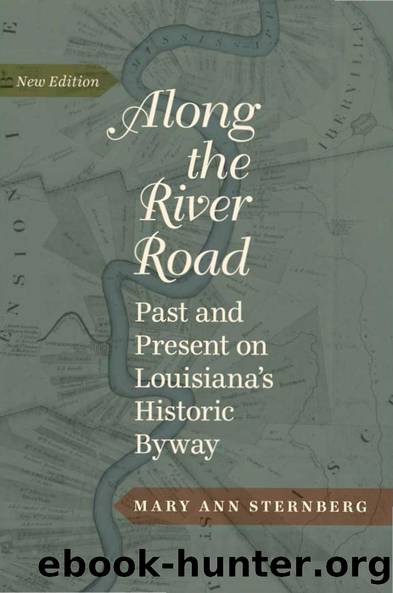Along the River Road by Mary Ann Sternberg

Author:Mary Ann Sternberg [Sternberg, Mary Ann]
Language: eng
Format: epub
Tags: Social Science, Regional Studies, Nature, Environmental Conservation & Protection
ISBN: 9780807150788
Google: 4NOoCv8UO6IC
Publisher: LSU Press
Published: 2013-04-15T02:47:58+00:00
Linwood, derelict, in a WPA photograph taken shortly before the houseâs demolition in 1939. Courtesy State Library of Louisiana
Author Eliza Ripley, describing a trip to Linwood in 1849, was duly impressed: âThe culmination of landscape wall paper must have been reached in the Minor plantation dwellingâ¦. The hall was broad and long, adorned with real jungle scenes from India. A great tiger jumped out of dense thickets⦠tall trees reached to the ceiling with gaudy striped boa-constrictors wound around their trunks; hissing snakes peered out of the jungles; birds of gay plumage⦠almost out of sight in the greenery; monkeys swung from limb to limb. To cap the climax, right close to the steps one had to mount to the story above was a lair of ferocious lions.â
During the Civil War, the house was raided by Union soldiers. The property remained in the family for seventy-five years. It was abandoned in 1900. The mansion was considered beyond restoration and demolished in 1939 by new owners who turned the property into a stock farm.
52.6 Cottage Farm Drive into the IMTT plant is the site of Cottage Farm Plantation. A small cemetery remains on the property. The previous occupant of the site, BASF, was the first chemical plant to locate in the Geismar area.
53.3 Rubicon, Inc. (Liquid Carbonic) is on the site of Doyal/Mount Houmas Plantation, originally called Doyalâs Plantation and owned by Henry R. Doyal. In 1852 Doyal converted his sugar mill to multiple-effect processing and milled the cane from neighboring properties such as Linwood, Waterloo, and his own Hard Times. (Doyal, however, should not be confused with Dr. Henry A. Doyle, who owned Eureka Plantation on the west bank.) He established New River Landing and Road to serve his sugar mill and the adjacent properties; the road site has become the approximate route of La. 73. The plantation was sold after the Civil War. By 1896, it was called Mount Houmas and was owned by J. Crosley.
During the war, Doyal was a captain in the Confederate army and was regarded as a guerrilla by the Union army because of his tactics. His plantation was also the scene of a battleâa skirmish, reallyâfought in August of 1864. Some two hundred members of the 11th New York Cavalry encamped there were surrounded by a Confederate force; somewhat more than half of the northerners fought their way clear, but the rest were captured.
The patch of woods is thought to be the relic site of a crevasse that inundated this area in the 1850s.
53.8 Junction La. 73. The town of Geismar was formerly called New River, named for a distributary of the Mississippi that branched from the river here. (It was cut off when the levees were constructed in the 1820s and can be found farther inland.) Iberville noted a Bayougoula village near New River in 1699; Europeans had settled the area by 1736. A public road ran inland from New River Landing on the Mississippi to Sorrentoâas late as the 1890s, the only road anywhere nearby that connected the river to the interior.
Download
This site does not store any files on its server. We only index and link to content provided by other sites. Please contact the content providers to delete copyright contents if any and email us, we'll remove relevant links or contents immediately.
| Africa | Americas |
| Arctic & Antarctica | Asia |
| Australia & Oceania | Europe |
| Middle East | Russia |
| United States | World |
| Ancient Civilizations | Military |
| Historical Study & Educational Resources |
Machine Learning at Scale with H2O by Gregory Keys | David Whiting(4183)
Never by Ken Follett(3793)
Fairy Tale by Stephen King(3220)
The Man Who Died Twice by Richard Osman(2997)
Oathbringer (The Stormlight Archive, Book 3) by Brandon Sanderson(2885)
Will by Will Smith(2793)
Rationality by Steven Pinker(2291)
The Dark Hours by Michael Connelly(2244)
Can't Hurt Me: Master Your Mind and Defy the Odds - Clean Edition by David Goggins(2228)
The Dawn of Everything: A New History of Humanity by David Graeber & David Wengrow(2122)
Friends, Lovers, and the Big Terrible Thing by Matthew Perry(2119)
Principles for Dealing With the Changing World Order: Why Nations Succeed and Fail by Ray Dalio(1974)
HBR's 10 Must Reads 2022 by Harvard Business Review(1777)
A Short History of War by Jeremy Black(1762)
Go Tell the Bees That I Am Gone by Diana Gabaldon(1687)
515945210 by Unknown(1599)
A Game of Thrones (The Illustrated Edition) by George R. R. Martin(1589)
Kingdom of Ash by Maas Sarah J(1526)
443319537 by Unknown(1470)
